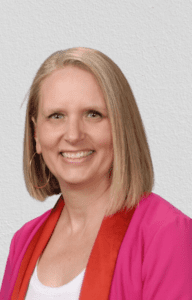

From the Desk of
Shelly Manuel ¦ Associate Partner
Remote Work and the Fundraiser
I remember the time when women couldn’t go to work without socks or hosiery and men wore ties every day but Friday—now, for many employees, you don’t even have to wear pants to “work.” A huge reality that arose from the pandemic is a world of remote workers. For a relationships-based industry such as fundraising, how feasible is a remote development office? Are we missing the boat requiring more and more onsite employees post-pandemic?
An article posted by the National Council of Nonprofits about a year ago reveals some interesting data. With 43% of job applicants desiring fully remote work when searching for nonprofit positions, only 19% of listings are for fully remote roles. Ironically, 43% of posts are for on-site employees and the final 38% for a hybrid workplace. Remote jobs received nine times as many applications as onsite or hybrid positions. Looks like nonprofit leadership and hiring teams need to start looking at remote or hybrid work options a little deeper.
To be blunt, jobs got done all over the world during the pandemic, so we know remote jobs can be effective. Working outside of the office provides a better work-life balance for employees, saves costs for the nonprofit, and provides access to top talent that isn’t restricted by geography. However, can employees be relied upon to remain effective and high performing? Issues around communication and collaboration can be a challenge on virtual teams, which can have a negative impact on organizational culture. In industries where program services require employees to be on-site, the optics of support staff, such as development, “never being in the office,” can be a challenge.
Personally, I prefer a hybrid work week. I need face-to-face interaction to make me happy and fulfilled professionally. Likewise, I can foster connections with highly personal and effective virtual meetings. Hybrid work almost forces development officers to “get out from behind” their desks. With this flexibility, there is more of an opportunity for in-person cultivation touches. In addition, expensive travel for short visits and meetings can be significantly reduced through balancing in-person and virtual visits.
Some people would much rather be fully productive from a home office, and many high-performing and connected teams hardly ever see each other in person. Roles that do not really require donor interaction, such as researchers, some advancement services, etc., could very well be fully remote jobs.
The partners at the firm had a wonderful online collaboration on this topic (interestingly, this all happened over email), and I would imagine that most nonprofit professionals have differing opinions on this subject. I don’t have the magic solution or answer, but I do know that our industry must keep an open mind and continue to explore how to best strategize around on-site, remote and hybrid work.
Gen Z Donors Are Coming. Here’s What You Need to Know
Although members of Generation Z are still far from their prime giving years, it’s never too soon for fundraisers to learn how to attract their support. A new report offers some insights into how Gen Z — born from 1997 to 2005 — likes to give and corrects some common misconceptions about their philanthropic style.
Key Findings
- 19% said they donate money, but 84% said they support nonprofits or causes in some way — including by volunteering (33%) or following or promoting them on social media (25%). A third of Gen Z donors said they plan to give more as the year progresses.
- 14% of nonprofit professionals thought Gen Z donors would find a thank-you letter meaningful, but actually, 34% of those donors did. 57% said they would give more if an organization mailed them a thank-you note.
- While 63% of fundraisers surveyed said they thought Gen Z donors were giving through social media, only 23% of Gen Zers said that was the case.
- 52% of those surveyed said they turn to social media to research organizations they’re considering supporting.
- 21% said they felt they could make the biggest difference on causes that mattered to them by promoting them on social media.
- 22% said the same about volunteering, and 18% about advocating. Just 11% said they felt they could make the biggest difference by giving.
- Much lower proportions of Gen Z reported donating through traditional channels — such as through monthly giving programs (8%), in response to an email appeal (8%), or in response to a mailed appeal (8%). Gen Zers were far more likely to say they made a donation at a checkout counter (40%), at a fundraising event (30%), or through the nonprofit’s website (29%).
- 42% said they tend to give spontaneously. 56% of Gen Z donors said they prefer to give “periodically, when I feel like it.” 18% said they like to give annually, and 11% said they make monthly gifts.
The report, Gen Z at the Table, from the Blackbaud Institute, can be found here.
COP, 5-7
Value of Volunteer Time Increases
The value of a volunteer hour in the US during 2023 was $33.49, up $4.95 from 2020. It’s a 5.3% increase from 2022. The value is estimated from data collected in 2023, and the figure illustrates the valuable and significant contributions that volunteers make every day to support our communities and nation.
In a state-by-state comparison (including the District of Columbia and Puerto Rico), Massachusetts had the highest volunteer value at $40.97 per hour, followed closely by Washington state at $40.28. The lowest state value was in Mississippi at $25.42. It was $15.82 per hour for Puerto Rico and $50.88 per hour for the District of Columbia.
The latest value, calculated by the University of Maryland’s Do Good Institute, is based on annual average hourly earnings estimates from the U.S. Bureau of Labor Statistics (BLS).
Charitable organizations most frequently use the value of volunteer time to recognize the amount of community support they receive from their volunteers. Corporations also use the figure to calculate the value of staff volunteer efforts in communities nationwide. The Nonprofit Times, 4-23
9 Ways to Raise More From Donor-Advised Funds
1. Don’t wait until December to focus on DAF gifts.
Don’t wait until December to start asking donors to make a DAF gift…you might not get the money by the end of the year. Ask donors, “Have you done a health check on your DAF lately?” and mentioning DAFs in fundraising appeals to donors at all levels.
2. Remind DAF donors to ask for a distribution.
DAF account holders must take action to trigger a donation. Some assume their DAF provider automatically makes distributions to charities each year. Suggest automatic distributions from DAFs as a way to make giving easier for donors while securing recurring income for your nonprofit.
3. Make the most of your data.
For starters, gather as much data as possible on DAF gifts and analyze reports regularly. Look for patterns, such as fund providers that make a high volume of distributions to your organization and advisers or other employees at those institutions who were involved, which can help guide your outreach strategies.
4. Treat DAF supporters like potential big donors.
Look at data on gift amounts and renewal rates of DAF donors to gain insights into their giving capacity and determine how best to engage them. If a first-time supporter makes a $100 gift through a DAF, treat them as if they have given at a higher level. This special attention can help increase giving from individuals with DAFs.
5. Try to learn more about anonymous donors.
Processing an anonymous DAF gift? Call the sponsoring organization to say thanks and verify that there is no additional information about the donor that your organization could use to steward them. You may be surprised how much more information you can receive.
6. Connect with DAF administrators and advisers.
These professionals want to be helpful advisers to their clients. Make their jobs easier by providing simple talking points about your work, which can be shared with donors who are interested.
7. Tap into your networks.
Attend philanthropic events in your city and try to meet people who work at DAF sponsoring organizations. Ask how your nonprofit could be good partners to them and help them serve clients interested in your work. Try to build bridges to these professionals through existing supporters.
8. Promote DAFs as planned gifts.
Some DAFs become “orphans” when the person who owns the fund dies with no plan for a successor adviser and no clear direction on how the money should be spent. Be smart and talk to your donors about leaving their DAFs your organization in their will or including it among the beneficiaries. Mention DAFs in marketing materials about planned giving to make sure donors keep them in mind as another way to leave a legacy.
9. Just ask.
Ask your donors if they have a DAF; if so, encourage them to give through it.
COP, 4-23
Welcome Returning Client Partner

We Know Museums
For more than 35 years, Alexander Haas has been a fixture in the nonprofit community. We are honored to have worked with leading museums and cultural organizations across the country that help communities be a better place to live. Just ask our clients.
Face It: Museums are Different
Our services aren’t cookie cutter. We don’t operate with a boilerplate, merely changing names and locations. We craft each and every service we provide to match your museum’s unique needs, wants and abilities. We work hard and expect you to do the same. Together we can help you transform your museum, your fundraising, and the community you serve.
Whether your need is in Capital Campaign, Annual Fund Campaign, Major Gifts, Leadership Annual Giving, Planned Giving or all of the above, we take a fresh approach to nonprofit fundraising.


